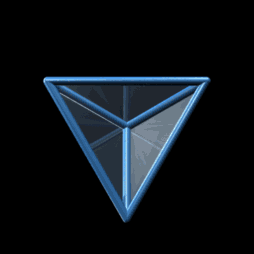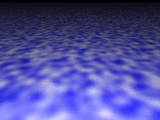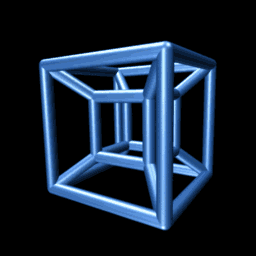|
Pentachoron
In geometry, the 5-cell is the convex 4-polytope with Schläfli symbol . It is a 5-vertex four-dimensional object bounded by five tetrahedral cells. It is also known as a C5, hypertetrahedron, pentachoron, pentatope, pentahedroid, tetrahedral pyramid, or 4-simplex (Coxeter's \alpha_4 polytope), the simplest possible convex 4-polytope, and is analogous to the tetrahedron in three dimensions and the triangle in two dimensions. The 5-cell is a 4-dimensional pyramid with a tetrahedral base and four tetrahedral sides. The regular 5-cell is bounded by five regular tetrahedra, and is one of the six regular convex 4-polytopes (the four-dimensional analogues of the Platonic solids). A regular 5-cell can be constructed from a regular tetrahedron by adding a fifth vertex one edge length distant from all the vertices of the tetrahedron. This cannot be done in 3-dimensional space. The regular 5-cell is a solution to the problem: ''Make 10 equilateral triangles, all of the same size, usin ... [...More Info...] [...Related Items...] OR: [Wikipedia] [Google] [Baidu] |
Rectified 5-cell
In four-dimensional geometry, the rectified 5-cell is a uniform 4-polytope composed of 5 regular tetrahedral and 5 regular octahedral cells. Each edge has one tetrahedron and two octahedra. Each vertex has two tetrahedra and three octahedra. In total it has 30 triangle faces, 30 edges, and 10 vertices. Each vertex is surrounded by 3 octahedra and 2 tetrahedra; the vertex figure is a triangular prism. Topologically, under its highest symmetry, ,3,3 there is only one geometrical form, containing 5 regular tetrahedra and 5 rectified tetrahedra (which is geometrically the same as a regular octahedron). It is also topologically identical to a tetrahedron-octahedron segmentochoron. The vertex figure of the ''rectified 5-cell'' is a uniform triangular prism, formed by three octahedra around the sides, and two tetrahedra on the opposite ends. Despite having the same number of vertices as cells (10) and the same number of edges as faces (30), the rectified 5-cell is not self-dual bec ... [...More Info...] [...Related Items...] OR: [Wikipedia] [Google] [Baidu] |
Truncated 5-cell
In geometry, a truncated 5-cell is a uniform 4-polytope (4-dimensional uniform polytope) formed as the Truncation (geometry), truncation of the regular 5-cell. There are two degrees of truncations, including a bitruncation. Truncated 5-cell The truncated 5-cell, truncated pentachoron or truncated 4-simplex is bounded by 10 cell (geometry), cells: 5 tetrahedron, tetrahedra, and 5 truncated tetrahedron, truncated tetrahedra. Each vertex is surrounded by 3 truncated tetrahedra and one tetrahedron; the vertex figure is an elongated tetrahedron. Construction The truncated 5-cell may be constructed from the 5-cell by Truncation (geometry), truncating its vertices at 1/3 of its edge length. This transforms the 5 tetrahedral cells into truncated tetrahedra, and introduces 5 new tetrahedral cells positioned near the original vertices. Structure The truncated tetrahedra are joined to each other at their hexagonal faces, and to the tetrahedra at their triangular faces. Seen in a configur ... [...More Info...] [...Related Items...] OR: [Wikipedia] [Google] [Baidu] |
5-cell Verf
In geometry, the 5-cell is the convex 4-polytope with Schläfli symbol . It is a 5-vertex four-dimensional space, four-dimensional object bounded by five tetrahedral cells. It is also known as a C5, hypertetrahedron, pentachoron, pentatope, pentahedroid, tetrahedral pyramid, or 4-simplex (Coxeter's \alpha_4 polytope), the simplest possible convex 4-polytope, and is analogous to the tetrahedron in three dimensions and the triangle in two dimensions. The 5-cell is a Hyperpyramid, 4-dimensional pyramid with a tetrahedral base and four tetrahedral sides. The regular 5-cell is bounded by five regular tetrahedron, regular tetrahedra, and is one of the six regular convex 4-polytopes (the four-dimensional analogues of the Platonic solids). A regular 5-cell can be constructed from a regular tetrahedron by adding a fifth vertex one edge length distant from all the vertices of the tetrahedron. This cannot be done in 3-dimensional space. The regular 5-cell is a solution to the problem: ''M ... [...More Info...] [...Related Items...] OR: [Wikipedia] [Google] [Baidu] |
Regular Tetrahedron
In geometry, a tetrahedron (: tetrahedra or tetrahedrons), also known as a triangular pyramid, is a polyhedron composed of four triangular Face (geometry), faces, six straight Edge (geometry), edges, and four vertex (geometry), vertices. The tetrahedron is the simplest of all the ordinary convex polytope, convex polyhedra. The tetrahedron is the three-dimensional case of the more general concept of a Euclidean geometry, Euclidean simplex, and may thus also be called a 3-simplex. The tetrahedron is one kind of pyramid (geometry), pyramid, which is a polyhedron with a flat polygon base and triangular faces connecting the base to a common point. In the case of a tetrahedron, the base is a triangle (any of the four faces can be considered the base), so a tetrahedron is also known as a "triangular pyramid". Like all convex polyhedra, a tetrahedron can be folded from a single sheet of paper. It has two such net (polyhedron), nets. For any tetrahedron there exists a sphere (called th ... [...More Info...] [...Related Items...] OR: [Wikipedia] [Google] [Baidu] |
3-simplex T0
In geometry, a tetrahedron (: tetrahedra or tetrahedrons), also known as a triangular pyramid, is a polyhedron composed of four triangular faces, six straight edges, and four vertices. The tetrahedron is the simplest of all the ordinary convex polyhedra. The tetrahedron is the three-dimensional case of the more general concept of a Euclidean simplex, and may thus also be called a 3-simplex. The tetrahedron is one kind of pyramid, which is a polyhedron with a flat polygon base and triangular faces connecting the base to a common point. In the case of a tetrahedron, the base is a triangle (any of the four faces can be considered the base), so a tetrahedron is also known as a "triangular pyramid". Like all convex polyhedra, a tetrahedron can be folded from a single sheet of paper. It has two such nets. For any tetrahedron there exists a sphere (called the circumsphere) on which all four vertices lie, and another sphere (the insphere) tangent to the tetrahedron's faces. Re ... [...More Info...] [...Related Items...] OR: [Wikipedia] [Google] [Baidu] |
Hyperplane
In geometry, a hyperplane is a generalization of a two-dimensional plane in three-dimensional space to mathematical spaces of arbitrary dimension. Like a plane in space, a hyperplane is a flat hypersurface, a subspace whose dimension is one less than that of the ambient space. Two lower-dimensional examples of hyperplanes are one-dimensional lines in a plane and zero-dimensional points on a line. Most commonly, the ambient space is -dimensional Euclidean space, in which case the hyperplanes are the -dimensional "flats", each of which separates the space into two half spaces. A reflection across a hyperplane is a kind of motion ( geometric transformation preserving distance between points), and the group of all motions is generated by the reflections. A convex polytope is the intersection of half-spaces. In non-Euclidean geometry, the ambient space might be the -dimensional sphere or hyperbolic space, or more generally a pseudo-Riemannian space form, and ... [...More Info...] [...Related Items...] OR: [Wikipedia] [Google] [Baidu] |
Regular Convex 4-polytope
In mathematics, a regular 4-polytope or regular polychoron is a regular four-dimensional polytope. They are the four-dimensional analogues of the regular polyhedra in three dimensions and the regular polygons in two dimensions. There are six convex and ten star regular 4-polytopes, giving a total of sixteen. History The convex regular 4-polytopes were first described by the Swiss mathematician Ludwig Schläfli in the mid-19th century. He discovered that there are precisely six such figures. Schläfli also found four of the regular star 4-polytopes: the grand 120-cell, great stellated 120-cell, grand 600-cell, and great grand stellated 120-cell. He skipped the remaining six because he would not allow forms that failed the Euler characteristic on cells or vertex figures (for zero-hole tori: ''F'' − ''E'' + ''V'' 2). That excludes cells and vertex figures such as the great dodecahedron and small stellated dodecahedron . Edmund Hess (1843 ... [...More Info...] [...Related Items...] OR: [Wikipedia] [Google] [Baidu] |
Platonic Solids
In geometry, a Platonic solid is a convex, regular polyhedron in three-dimensional Euclidean space. Being a regular polyhedron means that the faces are congruent (identical in shape and size) regular polygons (all angles congruent and all edges congruent), and the same number of faces meet at each vertex. There are only five such polyhedra: Geometers have studied the Platonic solids for thousands of years. They are named for the ancient Greek philosopher Plato, who hypothesized in one of his dialogues, the '' Timaeus'', that the classical elements were made of these regular solids. History The Platonic solids have been known since antiquity. It has been suggested that certain carved stone balls created by the late Neolithic people of Scotland represent these shapes; however, these balls have rounded knobs rather than being polyhedral, the numbers of knobs frequently differed from the numbers of vertices of the Platonic solids, there is no ball whose knobs match the 20 ... [...More Info...] [...Related Items...] OR: [Wikipedia] [Google] [Baidu] |
Polychoron
In geometry, a 4-polytope (sometimes also called a polychoron, polycell, or polyhedroid) is a four-dimensional polytope. It is a connected and closed figure, composed of lower-dimensional polytopal elements: vertices, edges, faces (polygons), and cells (polyhedra). Each face is shared by exactly two cells. The 4-polytopes were discovered by the Swiss mathematician Ludwig Schläfli before 1853. The two-dimensional analogue of a 4-polytope is a polygon, and the three-dimensional analogue is a polyhedron. Topologically 4-polytopes are closely related to the uniform honeycombs, such as the cubic honeycomb, which tessellate 3-space; similarly the 3D cube is related to the infinite 2D square tiling. Convex 4-polytopes can be ''cut and unfolded'' as nets in 3-space. Definition A 4-polytope is a closed four-dimensional figure. It comprises vertices (corner points), edges, faces and cells. A cell is the three-dimensional analogue of a face, and is therefore a polyhedron. Each ... [...More Info...] [...Related Items...] OR: [Wikipedia] [Google] [Baidu] |
SO(4)
In mathematics, the group (mathematics), group of rotations about a fixed point in four-dimensional space, four-dimensional Euclidean space is denoted SO(4). The name comes from the fact that it is the special orthogonal group of order 4. In this article ''rotation (mathematics), rotation'' means ''rotational displacement''. For the sake of uniqueness, rotation angles are assumed to be in the segment except where mentioned or clearly implied by the context otherwise. A "fixed plane" is a plane for which every vector in the plane is unchanged after the rotation. An "invariant plane" is a plane for which every vector in the plane, although it may be affected by the rotation, remains in the plane after the rotation. Geometry of 4D rotations Four-dimensional rotations are of two types: simple rotations and double rotations. Simple rotations A simple rotation about a rotation centre leaves an entire plane through (axis-plane) fixed. Every plane that is completely orthogonal to ... [...More Info...] [...Related Items...] OR: [Wikipedia] [Google] [Baidu] |
120-cell
In geometry, the 120-cell is the convex regular 4-polytope (four-dimensional analogue of a Platonic solid) with Schläfli symbol . It is also called a C120, dodecaplex (short for "dodecahedral complex"), hyperdodecahedron, polydodecahedron, hecatonicosachoron, dodecacontachoron and hecatonicosahedroid. The boundary of the 120-cell is composed of 120 dodecahedral cell (mathematics), cells with 4 meeting at each vertex. Together they form 720 pentagonal faces, 1200 edges, and 600 vertices. It is the 4-Four-dimensional space#Dimensional analogy, dimensional analogue of the regular dodecahedron, since just as a dodecahedron has 12 pentagonal facets, with 3 around each vertex, the ''dodecaplex'' has 120 dodecahedral facets, with 3 around each edge. Its dual polytope is the 600-cell. Geometry The 120-cell incorporates the geometries of every convex regular polytope in the first four dimensions (except the polygons and above). As the sixth and largest regular convex 4-polytope, it ... [...More Info...] [...Related Items...] OR: [Wikipedia] [Google] [Baidu] |




